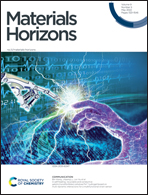Origin of multiple voltage plateaus in P2-type sodium layered oxides†
Abstract
Although layered transition metal (TM) oxides have attracted considerable attention for cathode materials of sodium-ion batteries, they suffer from uncontrolled multiple voltage plateaus due to local structure transformations such as TM-layer gliding and Na+/vacancy ordering upon Na+ extraction and insertion. However, the intrinsic origins of these local structure transformations are not fully understood, preventing the rational design of better cathode materials. Here, we concentrate on Na+/vacancy ordering in single phase domains to reveal the underlying mechanism of multiple voltage plateaus by tracking desodiation-induced electronic structure evolutions of two typical compounds, P2-Na0.6[Cr0.6Ti0.4]O2 and P2-NaCrO2. During desodiation, P2-NaCrO2 generates obvious multiple voltage plateaus, which are not observed in P2-Na0.6[Cr0.6Ti0.4]O2 due to TM disordering. A combination of first-principles desodiation calculations and electronic structure analysis reveals that charge localization accompanied by Na+ migration is an intrinsic feature of multiple voltage plateaus in P2-NaCrO2. A correlation between charge localization and multiple voltage plateaus is established by a comparative study in which P2-Na0.6[Cr0.6Ti0.4]O2 always follows the charge transfer order from high-activity to low-activity sites. This finding reveals that disordering design of active sites to avoid charge localization in redox is of much importance for developing high-performance Na-ion cathode materials.



 Please wait while we load your content...
Please wait while we load your content...